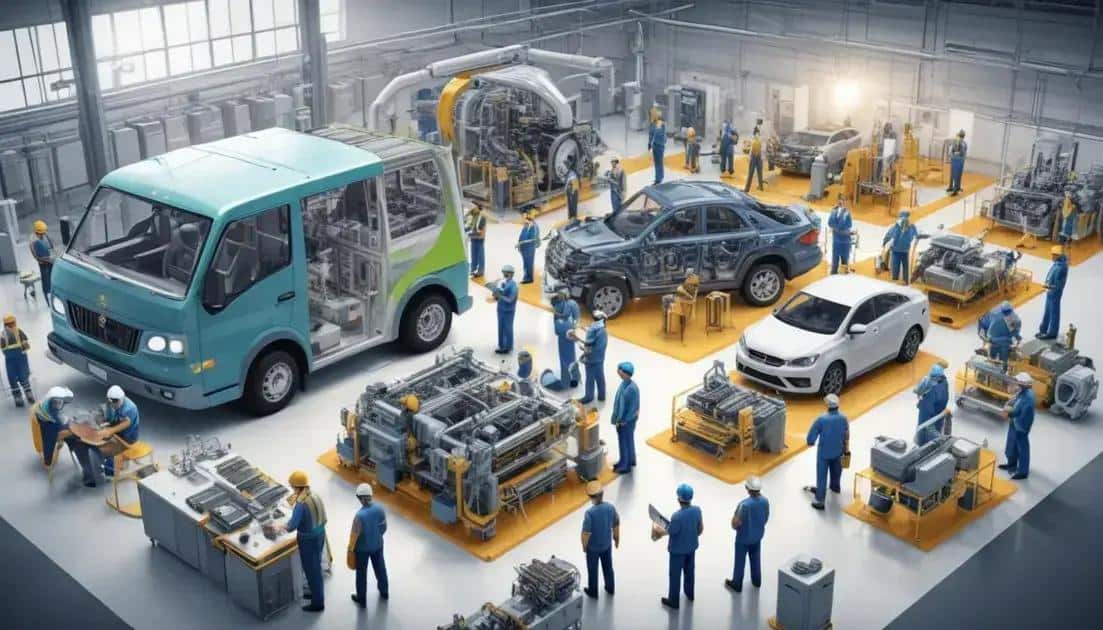Biden’s initiative to revitalize American manufacturing

Biden’s initiative to revitalize American manufacturing focuses on innovation, sustainability, and workforce development to create jobs, enhance economic growth, and ensure competitiveness in the global market.
Biden’s initiative to revitalize American manufacturing seeks to restore the heart of American industry and boost job creation. Have you thought about how this could reshape local economies across the nation? Let’s dive into what this initiative means for all of us.
Understanding Biden’s initiative
Understanding Biden’s initiative involves looking closely at its goals and the broader impact on American manufacturing. This initiative aims to strengthen the manufacturing sector, ensuring it remains competitive in a global landscape.
The efforts include investments in new technologies and infrastructure. By focusing on modern manufacturing practices, the initiative hopes to create jobs and promote sustainable industry practices.
Key Components of the Initiative
To achieve these ambitious goals, several key components have been outlined. Each aspect plays a crucial role in revitalizing manufacturing in America.
- Investment in advanced technology
- Support for small and medium-sized enterprises
- Focus on sustainable practices
- Enhancing workforce skills through training programs
By combining these elements, Biden’s initiative can lay a solid foundation for future growth. It’s important to understand the interconnectedness of these components as they work together.
Impact on Global Competition
The global market is competitive, and America needs to keep pace. This initiative not only aims to bring jobs back home but also to position U.S. manufacturing on the world stage. With investment in innovation, American products can compete more effectively.
A key aspect is the focus on boosting local economies. As manufacturers grow and hire more workers, communities receive a significant economic boost. This is beneficial not just for individuals, but for the overall economy.
- Increased job opportunities
- Higher wages for workers
- Revitalized local businesses
Moreover, enhancing the workforce is essential. Training programs can help equip workers with the necessary skills needed for the evolving manufacturing landscape. This ensures that they can find good jobs in the new economy.
Impact on local economies
The impact on local economies from Biden’s initiative to revitalize American manufacturing is profound. This initiative is designed to create jobs and stimulate economic growth in communities across the nation.
As manufacturers expand, they encourage spending in local areas, benefiting retailers, service providers, and other businesses. This ripple effect can lead to a stronger community overall.
Job Creation and Employment Opportunities
One of the most direct effects is the increase in job opportunities. With more factories operating, local residents can find jobs closer to home. This reduces commuting time and increases satisfaction.
- New jobs in production and assembly
- Support roles in logistics and management
- Opportunities for skilled trades and apprenticeships
Additionally, as wages rise with demand for skilled workers, families have more disposable income. This can lead to increased spending in local shops and services.
Boosting Local Businesses
The revitalization of manufacturing also propels growth in small businesses. As large manufacturers set up operations, they often need supplies and services from local companies. This creates a network effect that benefits everyone.
Moreover, local businesses can offer unique products that cater to the needs of manufacturers. This collaboration leads to innovation and diversification of products available in the market.
- Increased demand for local goods
- Collaboration between small and large businesses
- Enhanced entrepreneurial opportunities
As investments pour into community infrastructure, roads, and utilities, local residents benefit from improved services. This can attract further investments and boost overall living standards.
Key sectors benefiting from revitalization

The key sectors benefiting from revitalization in American manufacturing are diverse and crucial for the economy. Biden’s initiative targets specific industries that can drive growth and innovation.
One major sector is the technology industry. By embracing advanced manufacturing processes, companies can produce high-tech products more efficiently. This not only creates jobs but also strengthens the U.S. position in the global market.
Manufacturing and Advanced Technologies
Modern manufacturing relies heavily on technology. Factories that adopt new technologies often see significant improvements in productivity. As a result, sectors like electronics are flourishing.
- Increased production speed and efficiency
- Reduction in waste through precision manufacturing
- Higher quality products due to technological advancements
The automotive sector is another critical area. With a shift towards electric vehicles (EVs), manufacturing plants are being revamped to support new technologies. This shift is essential for reducing emissions and meeting future energy needs.
Renewable Energy Initiatives
Furthermore, the green energy sector is receiving increased attention. Renewable energy sources like solar and wind are essential for sustainable growth. Support for this sector creates jobs in manufacturing solar panels and wind turbines, benefiting both the economy and the environment.
Investing in these key sectors not only boosts employment but also fosters a sustainable future. As manufacturing evolves, so do the opportunities for American workers and businesses. This revitalization initiative aims to maximize potential across all these sectors.
Challenges faced by the manufacturing sector
The challenges faced by the manufacturing sector in the context of Biden’s initiative are significant and multifaceted. While revitalization efforts aim to boost this industry, several obstacles must be overcome for success.
One major challenge is the workforce shortage. As technology evolves, manufacturers need skilled workers who can operate complex machinery and software. This education gap can hinder growth by limiting the number of qualified candidates available for hire.
Supply Chain Disruptions
Another pressing issue is supply chain disruptions. Factors such as global trade tensions and natural disasters can affect the availability of essential materials. These disruptions can lead to delays in production and increased costs.
- Rising costs of raw materials
- Logistical challenges in transportation
- Dependence on foreign suppliers
In addition, regulatory challenges present obstacles. Manufacturers must comply with complex regulations that govern safety, labor, and environmental practices. While regulations are important for sustainability and protection, they can add layers of difficulty for manufacturers.
Competition from Abroad
Competition from foreign manufacturers also poses a significant hurdle. Countries with lower labor costs can produce goods more cheaply, putting pressure on U.S. manufacturers to remain competitive.
As a result, companies must innovate continuously to improve productivity and maintain their market share. Investing in new technologies and practices can require significant resources, which may be challenging for smaller businesses.
- Need for investment in research and development
- Pressure to adopt new technologies quickly
- Balancing cost-cutting with quality assurance
Addressing these challenges will require collaboration between government, businesses, and educational institutions to ensure a resilient and skilled workforce.
Future outlook for American manufacturing
The future outlook for American manufacturing looks promising as initiatives continue to focus on innovation and sustainability. There are several key trends that will shape the manufacturing landscape in the coming years.
One major trend is the adoption of automation and smart technologies. Factories are increasingly integrating robotics and artificial intelligence to enhance productivity and efficiency. This shift can lead to a reduction in costs and improved quality of products.
Growth of Green Manufacturing
Sustainability will play a crucial role. As consumers demand more environmentally friendly products, manufacturers are adapting their processes. Implementing green technologies can not only reduce carbon footprints but also provide a competitive edge.
- Use of renewable energy sources
- Reduction of waste in production processes
- Investment in sustainable materials
Additionally, the emphasis on local sourcing is gaining traction. With supply chain disruptions in recent years, many companies are looking to bring production closer to home. This shift supports local economies and can enhance the speed and reliability of supply chains.
Focus on Workforce Development
Workforce development will be essential to meet future demands. Companies will need to invest in training programs to prepare employees for high-tech roles in manufacturing. As job requirements evolve, educational institutions will also play a vital part in equipping the workforce with necessary skills.
Furthermore, partnerships between businesses, government, and educational institutions are expected to flourish. Collaborative efforts can lead to innovative solutions that address the challenges faced by the industry while promoting job creation.
- Increased collaboration for training programs
- Support for vocational and technical education
- Programs that enhance skills relevant to the evolving market
As these trends unfold, American manufacturing has the potential to remain competitive globally, fostering growth and innovation across various sectors.
In conclusion, the future of American manufacturing is bright and full of opportunities. The revitalization initiative aims to strengthen the industry by focusing on innovation, sustainability, and workforce development. By embracing technologies like automation and green practices, manufacturing can become more efficient and environmentally friendly. As industries adapt to new challenges, a skilled workforce will be essential to ensure that the U.S. remains competitive. With collaborative efforts among businesses, government, and educational institutions, there is a pathway to create jobs, enhance economic growth, and build a robust manufacturing sector for years to come.
FAQ – Questions about the Future of American Manufacturing
What role does automation play in the future of manufacturing?
Automation enhances production efficiency, reduces costs, and allows manufacturers to focus on high-quality output.
How can green practices benefit manufacturing companies?
Green practices can lower operational costs, improve sustainability, and attract environmentally conscious consumers.
What is the importance of workforce development in manufacturing?
Workforce development ensures employees have the skills needed for modern manufacturing processes, fostering innovation and competitiveness.
How do local sourcing initiatives impact communities?
Local sourcing supports community economies by creating jobs and reducing transportation costs, leading to a more resilient supply chain.






